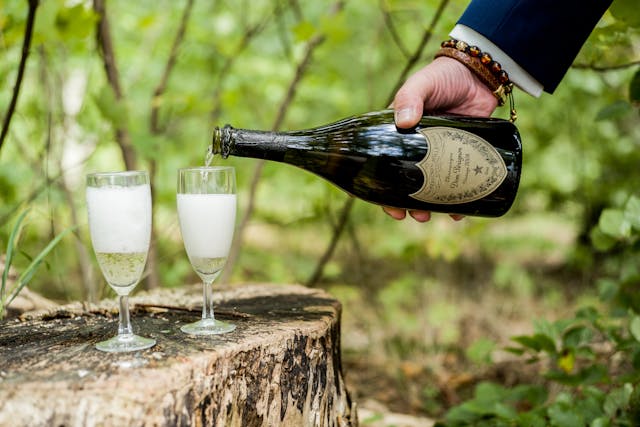
Why does champagne have bubbles but wine doesn’t? Champagne goes through a second fermentation that wine doesn’t.
Champagne has bubbles because of the way it is made. Regular wine would have bubbles if it was made in the same way, as can be seen by looking at sparkling wine. The only difference between champagne and sparkling wine is where the grapes come from and a few other small things.
The first step to make champagne is to harvest the grapes. There are eight different types of grapes used in champagnes. They are chardonnay, pinot noir, pinot meunier, pinot blanc, pinot gris, petit meslier, arbane, and voltis grapes. They all have a different taste and varying amounts of acidity. We tend to think of champagne as one thing, but there are huge varieties. The grapes are picked between August and October and they are usually picked by hand. Champagne is a luxury product and the level has to be kept high. Once the grapes have been picked, they are pressed to release the juices and the first fermentation is begun. Yeast is added so that all of the sugar in the grapes is fermented into alcohol.
About five months after they have been harvested and the wines have been harvested, wines from different grapes are blended together. Winemakers in the vineyards will decide how much of each grape to mix in. This is the point where most wines finish. However, champagnes have another step and it is what gives them their bubbles. The blended wines are fermented again. The wine is mixed with yeast, yeast nutrients, and sugar, and then poured into thick glass bottles before being sealed. The wine bottles are then placed in a cool cellar to continue fermenting. The yeast eats the sugar and turns it into alcohol and carbon dioxide. This carbon dioxide is where the champagne bubbles come from and it is this carbon dioxide which is the reason why the glass bottles have to be very thick. There is a lot of pressure inside the bottle and a regular wine bottle would probably shatter.
Once all of the sugar is gone, the yeast has nothing left to feed on and dies. It takes several months for this to happen, and a lot of champagnes are left for several years to age properly. However, the champagne is not yet finished. At this point, the champagne still has lots of dead yeast cells in it. The champagne makers want a yeasty taste, but they don’t want their customers to be drinking dead yeast. They need to get the yeast out and they have an ingenious way of doing that. The bottles are placed upside down in a holder at a 75-degree angle. The dead yeast cells slide down towards the end of the bottle and come to rest in the bottleneck. Every day, the bottle is turned by 1/8th to move the yeast a little more. This process is known as riddling and it is a procedure that was invented by Madame Veuve Cliquot, a name that still survives on some very expensive champagnes.
Once all of the dead yeast cells have settled in the neck of the bottle, they have to be removed. There is an ingenious method for doing this as well. They can’t just remove the cap on the bottle because all of the champagne will come out. Instead, they use an ice-salt bath to freeze the champagne with the dead yeast in the bottleneck. When the cap is taken off the bottle, the pressure caused by the carbon dioxide forces the frozen plug of champagne and yeast out, then the bottle can be capped again.
The champagne is still not finished. Before the bottle is corked, a mixture of white wine, brandy, and sugar are added to adjust the taste of the champagne and replace the frozen bit that came out with the yeast. The different quantities of wine, brandy, and sugar have different names. Brut Nature has less than 0.5 g of sugar per glass. Extra Brut has 1 g of sugar. Brut has 2 g of sugar. Extra dry has 2.8 g of sugar. Dry has 5.3 g of sugar. Semi Dry has 8.3 g of sugar. Doux has about 10 g of sugar per glass. The grapes used for champagne and the carbon dioxide can give it a sour taste, which the sugar removes. The less sugar, the sourer the taste. Once this has been added, the bottle is corked and the cork is wired down. The shape of the cork and the wire are designed to keep the cork in against the pressures that build up in the bottle because of the carbon dioxide. The bubbles in the bottle are constant and, apparently, the better the champagne, the smaller the bubbles. And this is what I learned today.
Photo by Rene Asmussen: https://www.pexels.com/photo/person-holding-bottle-of-champagne-pouring-into-clear-drinking-glasses-3167481/
Sources
https://winefolly.com/deep-dive/how-much-sugar-in-brut-champagne
https://www.champagne-booking.com/en/the-production-process-of-champagne

Pingback: What is baking soda?